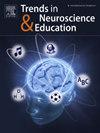Physiological correlates of math ability in higher education
IF 3
Q2 NEUROSCIENCES
引用次数: 0
Abstract
Background
Physiological responses offer a promising avenue for investigating emotional states associated with task performance. Yet, studies examining the physiological correlates of mathematical performance remain limited and conflicting.
Method
Here we investigated the relationship between math ability and three measures of physiological arousal (salivary cortisol, skin conductance, and heart rate variability) among 130 university students. We aimed to determine whether these associations varied across different levels of trait math anxiety and neuroticism.
Results
Results reveal that enhanced math ability was linked to an increase in cortisol overall and to either increase or decrease in skin conductance in students with low neuroticism depending on their field of study. Furthermore, distinct profiles of math anxiety, neuroticism, and physiological response emerged, displaying different math ability. No modulation by math anxiety and gender was found.
Conclusions
These findings emphasise the importance of incorporating neuroticism and students’ field of study for a comprehensive interpretation of physiological arousal in relation to math ability.
高等教育中数学能力的生理相关性
生理反应为研究与任务表现相关的情绪状态提供了一条很有前途的途径。然而,关于数学成绩的生理相关性的研究仍然有限且相互矛盾。方法研究了130名大学生的数学能力与生理唤醒指标(唾液皮质醇、皮肤电导和心率变异性)之间的关系。我们的目的是确定这些关联是否在不同水平的特质数学焦虑和神经质中有所不同。结果显示,数学能力的提高与皮质醇水平的总体增加有关,并且与低神经质学生皮肤电导的增加或减少有关,这取决于他们的学习领域。此外,数学焦虑、神经过敏和生理反应表现出不同的特征,表现出不同的数学能力。没有发现数学焦虑和性别的调节。这些发现强调了将神经质和学生的学习领域结合起来的重要性,以全面解释与数学能力有关的生理唤醒。
本文章由计算机程序翻译,如有差异,请以英文原文为准。
求助全文
约1分钟内获得全文
求助全文
来源期刊

Trends in Neuroscience and Education
NEUROSCIENCES-
CiteScore
6.30
自引率
6.10%
发文量
22
审稿时长
65 days
 求助内容:
求助内容: 应助结果提醒方式:
应助结果提醒方式:


